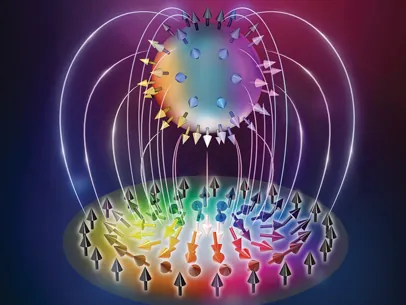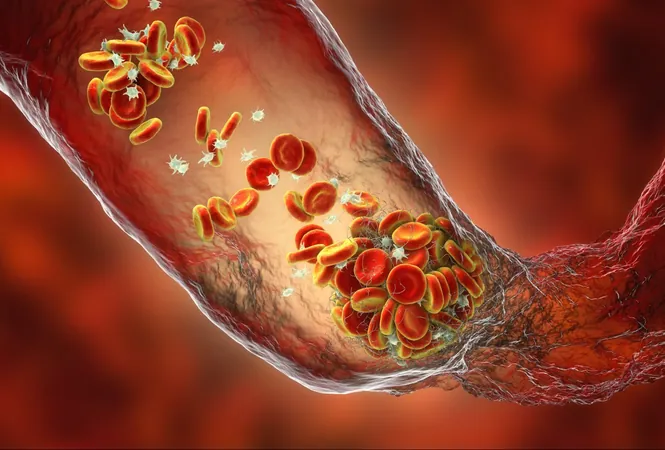
Skyrmions Take Flight: The Future of Light Waves
2025-04-21
Author: Wei
Revolutionizing Data Transfer with Topological Light Waves
In today's fast-paced world, where information overload is the norm, traditional electromagnetic waves are evolving. Enter the exciting realm of topological light waves—specifically, the dynamic and robust skyrmions—set to redefine how we transmit and secure data! Could tweaking the very topology of light be the breakthrough we need for faster, safer information transfer?
What Exactly Are Skyrmions?
First proposed by physicist Tony Skyrme in 1961, skyrmions are fascinating topological structures reminiscent of spiraled hedgehogs, demonstrating unique properties that have propelled them into the spotlight in both material science and data technology. These particle-like entanglements not only promise highly stable and efficient data storage but also provoke curiosity about their potential for long-range data transmission through light.
From Solids to Light: The Evolution of Skyrmions
Traditionally confined to solid materials, skyrmions have recently been translated into free-space optical fields, creating what we call optical skyrmions. Unlike their solid-state counterparts that primarily focus on data storage, these light-based entities have far-reaching potential to enhance communication, launching us into a new era of information transfer.
The Birth of Flying Skyrmions
In a groundbreaking leap over the past decade, researchers have tapped into toroidal electrodynamics—an emerging field in electromagnetism. This has led to the creation of 'flying skyrmions'—topologically structured electromagnetic pulses capable of riding the light wave at incredible speeds! Imagine these dynamic structures as 'flying doughnuts' that carry vast amounts of information without distortion.
The Promise of Supercharged Light Energy
Advancements have introduced a new category: supertoroidal pulses, which house multiple skyrmionic structures, generating remarkable physical phenomena such as fractal singularities. With ongoing attempts to stabilize and enhance these pulses, the goal is to ensure they can traverse long distances without losing their unique properties—opening a Pandora's box of applications!
Gaming the System: Skyrmion Generators
What if we could create a compact generator for these light skyrmions? Drawing inspiration from natural phenomena like air vortex cannons, researchers have designed an electromagnetic vortex cannon. This innovative device directly emits rugged electromagnetic vortex rings, showcasing self-healing qualities as they propagate. The implications? Imagine revolutionizing how we encode data, offer secure communications, and refine remote detection methods!
Expanding Horizons: Higher-Dimensional Topologies
But why stop there? The potential for higher-dimensional topologies, like the intriguing hopfions, represents a new frontier in skyrmion research. These 3D topological quasiparticles can reshape how we interact with the fabric of light itself, allowing for even richer and more complex data management.
Skyrmions in Water: Bridging Gaps Between Fluids and Light
Surprisingly, the mesmerizing world of topological structures has yet to fully explore water waves. Recent breakthroughs have successfully illustrated skyrmionic formations within water, revealing yet another layer of potential applications that bridge optical and acoustic technologies.
The Future is Topological!
As we stand on the brink of integrating these groundbreaking topological structures into everyday technology, the advancements in generator and detector systems will be pivotal. The next decade promises to further unveil the power of topological light waves, not just as concepts in physics but as practical tools reshaping our communication landscapes.
With myriad applications ranging from enhanced data transmission to intricate optical manipulation, the sky's the limit for skyrmions as they take flight!




 Brasil (PT)
Brasil (PT)
 Canada (EN)
Canada (EN)
 Chile (ES)
Chile (ES)
 Česko (CS)
Česko (CS)
 대한민국 (KO)
대한민국 (KO)
 España (ES)
España (ES)
 France (FR)
France (FR)
 Hong Kong (EN)
Hong Kong (EN)
 Italia (IT)
Italia (IT)
 日本 (JA)
日本 (JA)
 Magyarország (HU)
Magyarország (HU)
 Norge (NO)
Norge (NO)
 Polska (PL)
Polska (PL)
 Schweiz (DE)
Schweiz (DE)
 Singapore (EN)
Singapore (EN)
 Sverige (SV)
Sverige (SV)
 Suomi (FI)
Suomi (FI)
 Türkiye (TR)
Türkiye (TR)
 الإمارات العربية المتحدة (AR)
الإمارات العربية المتحدة (AR)